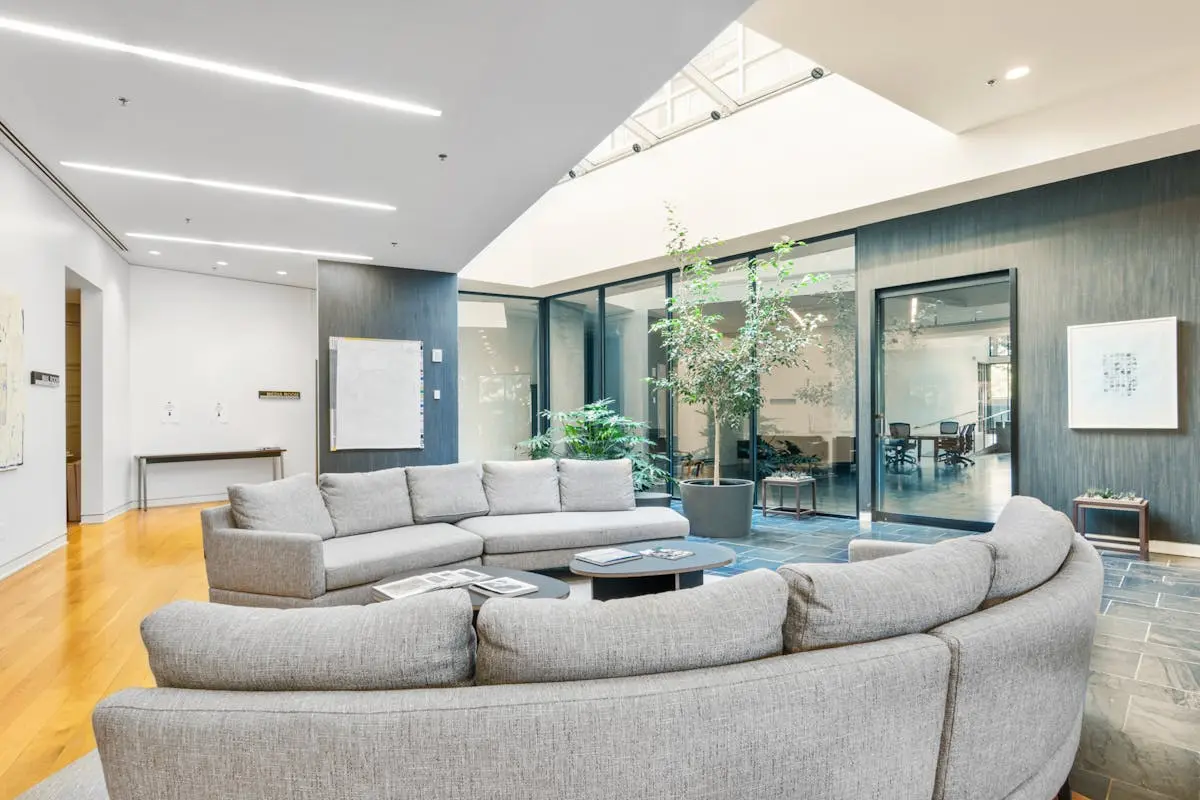10 Lounge Design Trends to Elevate Your Commercial Space
In today’s fast-paced business world, having a lounge space that’s not just practical but also stylish can really make a difference in your commercial environment. Whether you’re giving your current lounge a facelift or starting from scratch, keeping up with the latest trends can transform your area into an inviting haven. So, let’s dive into some of the hottest design trends that can elevate your commercial lounge to new heights!
1. Embracing Biophilic Design (AKA real plants)
The connection to nature is growing in popularity, with more lounge spaces incorporating natural elements like green walls or indoor plants to create a relaxing ambiance. This concept, known as biophilic design, integrates organic materials and elements, transforming what might otherwise be a sterile or uninspired area into a thriving oasis. By introducing elements such as live plant walls or strategically placed greenery, your lounge can become a serene retreat. Not only do plants improve air quality, but they also offer psychological benefits by reducing stress and enhancing mood. The ultimate aim is to blur the lines between indoors and outdoors, making spaces feel more open and inviting. To find inspiration on crafting inviting lounge areas, you might check out some design tips on how to master biophilic elements.
Incorporating water features, such as small indoor fountains, can further elevate the tranquility of your lounge. This natural touch not only serves aesthetic purposes but also produces calming white noise—a soothing backdrop for both clients and employees. The seating should also reflect this theme, with furniture made from natural materials like rattan, wood, and bamboo serving as a perfect fit. Nothing invites conversation and relaxation quite like a naturally inspired space that reflects the lushness of nature. This trend is more than just an aesthetic choice—it’s a way to promote well-being in the workplace. Considering how these elements can integrate seamlessly into your overall layout is key, and working with professionals who have a keen eye for adaptive design post-pandemic can ensure your space remains upon the cutting edge of design.
2. Mixing Vintage and Modern Elements
When it comes to mixing vintage and modern styles in your lounge, the right color palette can really pull everything together. Think of starting with some neutral tones as a solid base and then adding pops of bold, vintage-inspired colors like mustard yellow or teal. This way, your lounge will have that curated feel, rather than looking like a collection of random décor.
Don’t forget about those unique accessories! Items like antique lamps, quirky retro artwork, or even a vintage record player can bring in that nostalgic vibe without taking away from the lounge’s purpose. The magic happens when you find that sweet spot between vintage character and contemporary functionality.
Be intentional with your design—embrace each piece’s uniqueness while keeping in mind the big picture of your space. Whether you’ve got family heirlooms or funky finds from thrift shops, every item adds a layer to the story your lounge tells, and remember, your updated space should look well conceived and not curated from the thrift store down the street!
3. Flexible Seating Arrangements
With the evolving demands of workspaces, flexible seating solutions are becoming indispensable in lounge design. Modular sofas, reconfigurable tables, and movable chairs allow your lounge to adapt seamlessly from casual hangout to collaborative meeting area. This versatility is especially valuable in smaller spaces where multifunctionality can maximize usability. By designing your lounge as a flexible landscape of comfort and productivity, you can inspire dynamism among users and keep the energy fresh. An adaptable layout ensures that whether someone is seeking solitude to focus or a team needs to regroup and brainstorm, the space can cater to their needs without compromising on style.
4. Integrating Smart Technology
In today’s fast-paced environment, technology is no longer an optional luxury but an essential component of any well-designed lounge. Smart lounges equipped with seamless connectivity options, such as Wi-Fi-enabled furniture and discreet charging stations, cater to the expectations of tech-savvy visitors. Integrated audio-visual systems for presentations or ambient music create an engaging atmosphere, while lighting solutions that adjust with the time of day enhance the overall experience. Embracing technology not only keeps your space competitive but also elevates it to a modern standard that appeals to a tech-driven demographic. Ensuring that each technological element is user-friendly and necessary enhances the functionality of your area significantly.
5. Incorporating Artistic Features
Art is a powerful way to transform a lounge space into a visually stimulating environment. Incorporating large-scale artwork or vibrant murals can act as both a decorative element and a dynamic focal point. Art not only brings life to otherwise neutral spaces but also serves as a conversation starter for guests. Sculptures, paintings, and installations can reflect the personality and values of your business, providing an excellent medium to express your brand identity creatively. When selecting art for your lounge, consider how each piece fits into the overarching design and the impression you wish to leave on your guests.
6. Sustainable Material Choices
The choice of materials in design goes beyond aesthetics; it reflects a commitment to sustainability and social responsibility. By opting for eco-friendly materials, like reclaimed wood, recycled metals, or sustainable textiles, you not only make a positive environmental impact but also enhance the narrative of your space. Going green doesn’t mean compromising on design quality or aesthetics—many sustainable materials boast exquisite finishes and durability that compete head-to-head with their traditional counterparts. Highlighting your lounge’s sustainability can become part of your brand’s storytelling, resonating with eco-conscious clients and visitors. In today’s market, consumers are increasingly valuing businesses that prioritize sustainability, making this design choice both ethically and commercially wise.
7. Open Space Concepts
Open-plan lounges are a hallmark of modern design, celebrated for breaking down barriers and creating a sense of community. By removing physical divides, these spaces encourage open communication and collaboration while accommodating a fluid movement throughout the area. Such a layout is ideal for organizations that thrive on teamwork and creative exchange, allowing for spontaneous interactions and the sharing of ideas. Open spaces also promote an airy and inviting ambiance that can significantly uplift the mood of anyone who enters. While planning such a layout, clarity of purpose for each zone within the open area is crucial, ensuring functional efficiency without losing the warmth of a shared environment.
8. Accent Lighting Strategies
Lighting plays a pivotal role in setting the mood and functionality of a lounge. An interplay of different lighting strategies can both illuminate tasks and create comfortable, intimate settings. Consider incorporating a mix of task, ambient, and accent lighting to cater to varied events and moods. For instance, pendant lights can serve as dramatic focal points, while dimmable lighting systems offer flexibility for adjusting the brightness according to the time of day or occasion. Proper lighting confronts design challenges with sophistication and flair, benefiting from the emerging trends in smart lighting systems that can be controlled remotely to suit the user’s preferences.
9. Personalized Lounge Experiences
Today’s clients and employees appreciate a lounge that does more than just look good—they want an experience that feels tailored to them. Personalizing the lounge experience can be achieved through custom furnishings that represent the character of your brand or carefully curated playlists that set the right mood. Such bespoke touches make every visit unique, potentially increasing client satisfaction and employee morale. Crafting a space that feels tailored to its users involves paying close attention to their needs and preferences, offering elements like aroma diffusers for fragrance or regional artwork that celebrates the locality. Personalization makes the lounge memorable—an essential part of any commercial space. To explore how you can initiate this journey, consult insights about remodeling projects as a journey.
10. Multi-functional Space Design
Designing a lounge that serves multiple functions can greatly maximize its usage across different scenarios. From providing a quiet retreat for individual focus to hosting vibrant social gatherings, the space should accommodate a variety of functions seamlessly. This multi-purpose approach not only enhances the value of the space but also offers diverse utilities that can change along with the needs of your users. Consider integrating features like folding partitions, stackable furniture, and hideaway stations to effectively switch from one function to another at a moment’s notice. Implementing lightweight, portable furniture further simplifies the transformation of spaces, catering to relaxation, networking, and everything in between.








